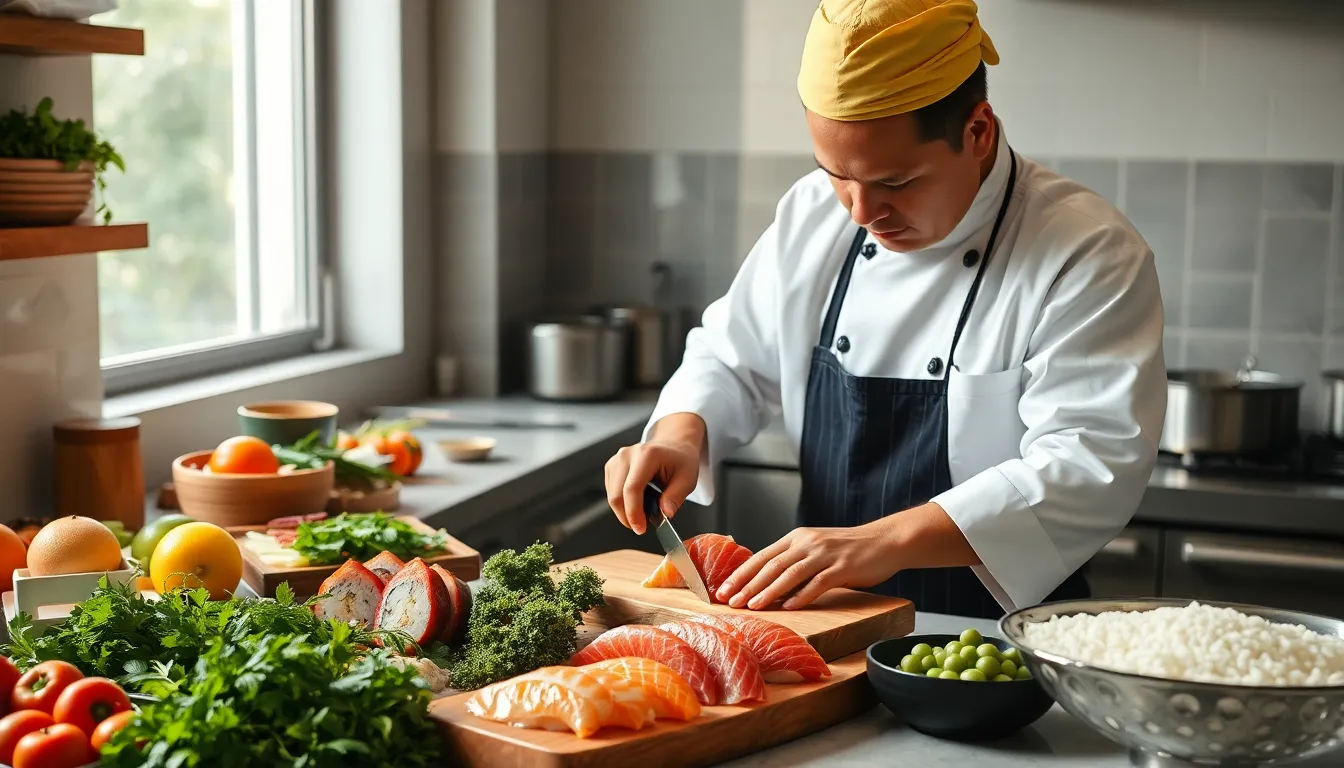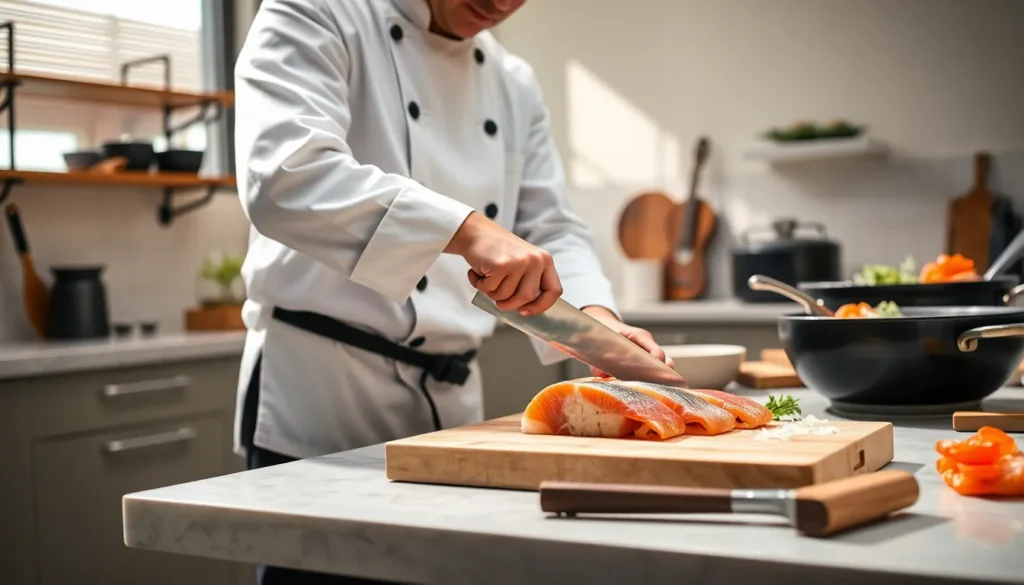Table of Contents
ToggleWhen it comes to cooking, Japan has elevated the craft to an art form that tantalizes the taste buds and soothes the soul. From the precise knife skills used in sushi preparation to the mesmerizing process of making dashi, Japanese cooking techniques are a blend of tradition and innovation. Whether you’re a novice eager to discover culinary secrets or a seasoned chef aiming to refine your skills, understanding these methods can transform your kitchen. Get ready to chop, simmer, and serve dishes that will impress friends and family alike.
Overview of Japanese Cooking Techniques

Japanese cooking techniques emphasize the harmony of flavors, aesthetics, and health. Each method reflects a deep respect for ingredients, often sourced locally and utilized in their purest forms. The cooking philosophy values simplicity, balance, and seasonality, allowing the natural tastes of ingredients to shine through. From the umami-rich taste of fermented foods to the freshness of raw dishes like sashimi, Japanese cooking creates a delightful culinary landscape.
The core techniques include steaming, simmering, grilling, and frying, each executed with precision. Skills such as slicing and presentation play a crucial role in the overall experience, making every meal not just food but a feast for the eyes. It’s this combination of taste and visual appeal that has made Japanese cuisine renowned worldwide.
Essential Tools for Japanese Cooking
To master Japanese cooking, having the right tools is essential. Key instruments include:
- Yanagiba Knife: This long, thin blade is perfect for slicing raw fish and is a staple in sushi preparation.
- Takoyaki Pan: Used to prepare the beloved takoyaki balls, this pan features specialized molds to achieve that perfect round shape.
- Donabe and Kinzan: Traditional earthenware pots ideal for slow-cooking rice or stews, creating a depth of flavor that’s hard to replicate.
- Miso Tsukuri Kyo: A special tool for mashing and mixing miso paste into various dishes, harnessing the full umami potential of this fermented powerhouse.
Investing in these essentials will provide a solid foundation for exploring the myriad techniques of Japanese cuisine.
Traditional Techniques
Japanese cooking is steeped in techniques that have been honed over centuries. Here are some of the most cherished methods:
Sashimi and Sushi Preparation
This involves razor-sharp knife skills to create precise cuts, ensuring fish is presented beautifully and tastes its best.
Dashi Making
Dashi, a traditional broth, forms the foundation of many Japanese dishes. It is typically made by simmering kombu (seaweed) and bonito flakes, extracting a deep, umami flavor that elevates soups and sauces.
Pickling (Tsukemono)
Pickling is another art form in Japan. Vegetables are carefully salted and fermented, creating crunchy and flavorful accompaniments that balance meals.
Grilling (Yakitori)
Skewered grilled chicken and vegetables are prepared over charcoal, imparting a smoky flavor that adds to the dish’s complexity.
These techniques not only create delicious food but also represent the stories, regions, and cultural heritage of Japan.
Modern Innovations in Japanese Cooking
While traditional techniques form the backbone of Japanese cuisine, modern innovations are making waves. Chefs are fusing traditional methods with international influences, creating dishes that cater to global palates.
Sous-Vide Techniques
This method allows for precise temperature control, ensuring meats and vegetables retain their moisture and flavor during cooking.
Molecular Gastronomy
Utilizing scientific techniques, chefs manipulate ingredients at a molecular level to create unexpected textures and flavors, adding a modern twist to classics.
Plant-Based Innovations
With a rising trend toward plant-based diets, chefs are creating vegan versions of traditional dishes using unique ingredients like tofu and tempeh, showcasing the versatility of Japanese cooking.
Modern Japanese chefs continue to push the boundaries, demonstrating that innovation can thrive alongside tradition.
Regional Variations in Techniques
Japan’s diverse regions boast unique culinary techniques shaped by local ingredients and climate.
Hokkaido
Known for its seafood, Hokkaido features techniques like seafood grilling and hot pot (shabu-shabu) that celebrate fresh catches from the surrounding waters.
Kansai
In Kansai, techniques such as tempura highlight the region’s love for light and crispy batter, showcasing its agricultural bounty.
Kyushu
Kyushu utilizes strong punchy flavors, incorporating techniques like smoking and slow-cooking, particularly in their renowned ramen dishes.
Okinawa
Known for its health-conscious cuisine, Okinawan cooking emphasizes methods such as boiling and simmering, utilizing local vegetables and herbs that promote longevity.
These regional variations add layers of richness to the already vibrant tapestry of Japanese cuisine.
Health Benefits of Japanese Cooking Techniques
Japanese cooking techniques offer an array of health benefits. The focus on fresh, seasonal ingredients means meals are generally low in processed foods and rich in nutrients.
Balanced Diet
Traditional meals often feature a balance of protein, carbohydrates, and vegetables, ensuring that meals fulfill nutritional needs without excess.
Fermented Foods
The use of fermented ingredients like miso and pickles contributes to gut health, a fundamental aspect of Japanese cuisine.
Mindful Eating
In Japan, dining is viewed as an experience to savor rather than just fuel, promoting mindful eating habits that can contribute to lower obesity rates.
By embracing these cooking techniques, individuals can benefit from a healthier lifestyle along with exquisite flavors.



